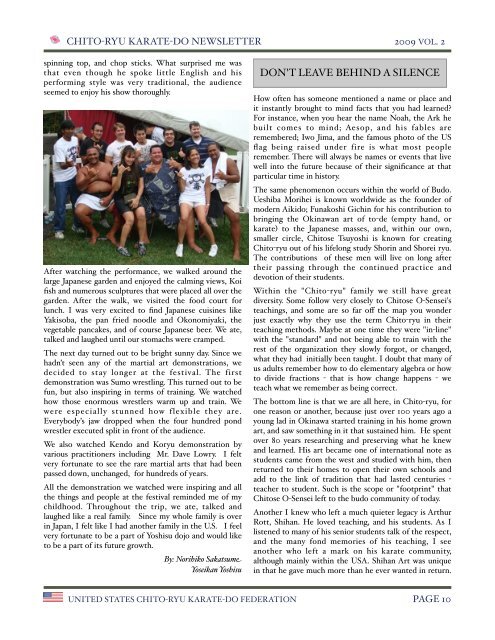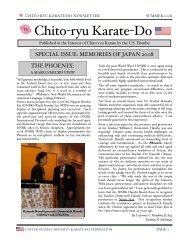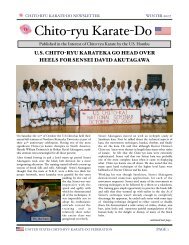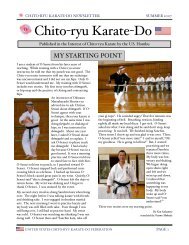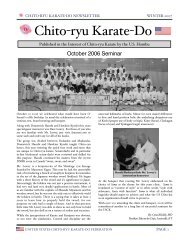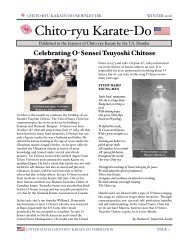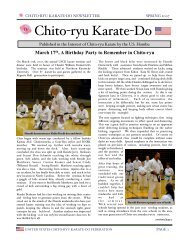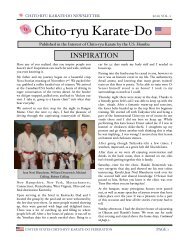2009 Volume 3 - United States Chito-ryu Karate Federation
2009 Volume 3 - United States Chito-ryu Karate Federation
2009 Volume 3 - United States Chito-ryu Karate Federation
Create successful ePaper yourself
Turn your PDF publications into a flip-book with our unique Google optimized e-Paper software.
CHITO-RYU KARATE-DO NEWSLETTER <strong>2009</strong> VOL. 2<br />
spinning top, and chop sticks. What surprised me was<br />
that even though he spoke little English and his<br />
performing style was very traditional, the audience<br />
seemed to enjoy his show thoroughly.<br />
After watching the performance, we walked around the<br />
large Japanese garden and enjoyed the calming views, Koi<br />
fish and numerous sculptures that were placed all over the<br />
garden. After the walk, we visited the food court for<br />
lunch. I was very excited to find Japanese cuisines like<br />
Yakisoba, the pan fried noodle and Okonomiyaki, the<br />
vegetable pancakes, and of course Japanese beer. We ate,<br />
talked and laughed until our stomachs were cramped.<br />
The next day turned out to be bright sunny day. Since we<br />
hadn’t seen any of the martial art demonstrations, we<br />
decided to stay longer at the festival. The first<br />
demonstration was Sumo wrestling. This turned out to be<br />
fun, but also inspiring in terms of training. We watched<br />
how those enormous wrestlers warm up and train. We<br />
were especially stunned how flexible they are.<br />
Everybody’s jaw dropped when the four hundred pond<br />
wrestler executed split in front of the audience.<br />
We also watched Kendo and Ko<strong>ryu</strong> demonstration by<br />
various practitioners including Mr. Dave Lowry. I felt<br />
very fortunate to see the rare martial arts that had been<br />
passed down, unchanged, for hundreds of years.<br />
All the demonstration we watched were inspiring and all<br />
the things and people at the festival reminded me of my<br />
childhood. Throughout the trip, we ate, talked and<br />
laughed like a real family. Since my whole family is over<br />
in Japan, I felt like I had another family in the U.S. I feel<br />
very fortunate to be a part of Yoshisu dojo and would like<br />
to be a part of its future growth.<br />
By: Norihiko Sakatsume<br />
Yoseikan Yoshisu<br />
DON'T LEAVE BEHIND A SILENCE<br />
How often has someone mentioned a name or place and<br />
it instantly brought to mind facts that you had learned?<br />
For instance, when you hear the name Noah, the Ark he<br />
built comes to mind; Aesop, and his fables are<br />
remembered; Iwo Jima, and the famous photo of the US<br />
flag being raised under fire is what most people<br />
remember. There will always be names or events that live<br />
well into the future because of their significance at that<br />
particular time in history.<br />
The same phenomenon occurs within the world of Budo.<br />
Ueshiba Morihei is known worldwide as the founder of<br />
modern Aikido; Funakoshi Gichin for his contribution to<br />
bringing the Okinawan art of to-de (empty hand, or<br />
karate) to the Japanese masses, and, within our own,<br />
smaller circle, <strong>Chito</strong>se Tsuyoshi is known for creating<br />
<strong>Chito</strong>-<strong>ryu</strong> out of his lifelong study Shorin and Shorei <strong>ryu</strong>.<br />
The contributions of these men will live on long after<br />
their passing through the continued practice and<br />
devotion of their students.<br />
Within the "<strong>Chito</strong>-<strong>ryu</strong>" family we still have great<br />
diversity. Some follow very closely to <strong>Chito</strong>se O-Sensei's<br />
teachings, and some are so far off the map you wonder<br />
just exactly why they use the term <strong>Chito</strong>-<strong>ryu</strong> in their<br />
teaching methods. Maybe at one time they were "in-line"<br />
with the "standard" and not being able to train with the<br />
rest of the organization they slowly forgot, or changed,<br />
what they had initially been taught. I doubt that many of<br />
us adults remember how to do elementary algebra or how<br />
to divide fractions - that is how change happens - we<br />
teach what we remember as being correct.<br />
The bottom line is that we are all here, in <strong>Chito</strong>-<strong>ryu</strong>, for<br />
one reason or another, because just over 100 years ago a<br />
young lad in Okinawa started training in his home grown<br />
art, and saw something in it that sustained him. He spent<br />
over 80 years researching and preserving what he knew<br />
and learned. His art became one of international note as<br />
students came from the west and studied with him, then<br />
returned to their homes to open their own schools and<br />
add to the link of tradition that had lasted centuries -<br />
teacher to student. Such is the scope or "footprint" that<br />
<strong>Chito</strong>se O-Sensei left to the budo community of today.<br />
Another I knew who left a much quieter legacy is Arthur<br />
Rott, Shihan. He loved teaching, and his students. As I<br />
listened to many of his senior students talk of the respect,<br />
and the many fond memories of his teaching, I see<br />
another who left a mark on his karate community,<br />
although mainly within the USA. Shihan Art was unique<br />
in that he gave much more than he ever wanted in return.<br />
UNITED STATES CHITO-RYU KARATE-DO FEDERATION PAGE 10


